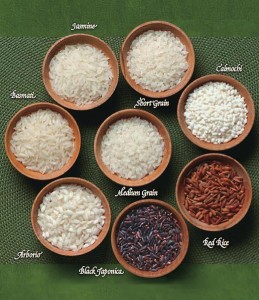Do you know how many different types of rice there are?
I was amazed to find out that there are 40,000 varieties worldwide!

When I grew up I knew about white rice, sticky rice, black/purple rice, fried rice or mixed rice, and thought that was it! (Of course the last two are not a type of rice, but rather a type of rice dish!) This article covers some of the most commonly used and known varieties of rice in the U.S., that I have personally used all my life.
Even though Americans eat twice as much rice now than they did 10 years ago, the average consumption per person is 25 lbs per year compared to people in Myanmar who eat 500 lbs a year. Yet, the U.S. is the 12th largest producer and the 2nd largest exporter of rice in the world. Rice originated in Asia and Africa, and feeding 1/3 of the world population clearly makes it one of the most important staples around the world.
There are many advantages to using rice, some of which are: it’s nutritious, high in complex carbohydrates, almost no fat, cholesterol free, low in sodium (except when salt is added), gluten-free and it is low in calories. Depending on the variety, half a cup of cooked white rice contains about 80 calories.
BASMATI RICE
A long-grain, aromatic but non-glutinous rice from India and Pakistan, swells only lengthwise when cooked, forms long slender grains that are very dry, light and separate—not sticky. In Hindi it means “queen of scents” or “pearl of scents.” This would have been excellent for my Chinese fried rice!
BLACK RICE
The black uncooked grains turn deep purple when cooked. Black rice has a nutty taste and is high in iron and fiber. It is steamed plain, used in pilaf, stir-fried or with a salad.
I have only had black rice as a chewy patty, sometimes stuffed with a sweet coconut or savory meat filling. Djenang Lot, Mendot or Lemper were the Javanese names for these treats I remember from my youth.
BROWN RICE
Brown rice is milled to remove only the hull from the kernel but the rice bran layer and the germ are retained. Brown rice has a lower glycemic index and is more nutritious because it does not loose the vitamins, minerals and fiber rich in minerals and vitamins, especially the B-complex. It takes twice as long to cook as white rice.
CONVERTED RICE
Or parboiled rice is pressure-steamed and dried before it is husked This causes the grains to absorb nutrients from the husk and is a good choice for people who want more nutritious rice, without having to eat brown rice. It almost has the same color and flavor as white rice, but can be a little bit drier. This is also used in fried or mixed rice (moksie alesie).
GLUTINOUS RICE
Better knows as sticky rice is short-grained rice that is especially glue-like when cooked. This can be used for desserts or savory dishes. I remember it as rice pudding or small rice balls sprinkled with sugar and freshly grated coconut (ketan klappa). When used in a savory dish, the cooked rice would be cut in cubes and served with fried tofu cubes, topped with fresh bean sprouts and a spicy sweet soy sauce (tahoe lontong). I also remember eating it in cubes with a Javanese curry-coconut beef stew (lonton with gule).
INSTANT RICE
Instant rice is precooked white rice that has been dehydrated to enable faster cooking. It is more expensive due to the convenience, but less flavorful than regular rice.
JASMINE RICE
This long-grain rice has a distinctive jasmine aroma during cooking. The cooked grains are soft, moist and cling together. (No wonder mine clumped!) Jasmine cooks in a similar way to basmati but has a rounder, starchier grain which makes it sticky, where basmati is not. Jasmine rice is a good source of B vitamins and complex carbohydrates.
WHITE RICE
Regular-milled white rice is the most common form of rice. Unfortunately, removing the bran and germ to make white rice more tender and delicate, also removes much of the nutrients.
WILD RICE
Wild rice is a cousin to true rice and instead of being cultivated, it grows wild in small lakes and slow-flowing streams.
Source: The Nibble.com
I love Jasmine rice and the regular white rice. Though there are a lot more varieties of white rice out there in Asia.
Hi there! This is Malini…I came across your site after browsing for types of rice…I have made a reference of your post in my blog……
Thanks for the reference Mailini. You have a great site!
Hello Recipe Collector!
I agree, Jasmine rice is also my favorite. The fragrance only makes me hungry 🙂
BASMATI!!!
I think jasmine rice is the best tasting rice.I love how it is soft and the nutrients of the rice is incredible!